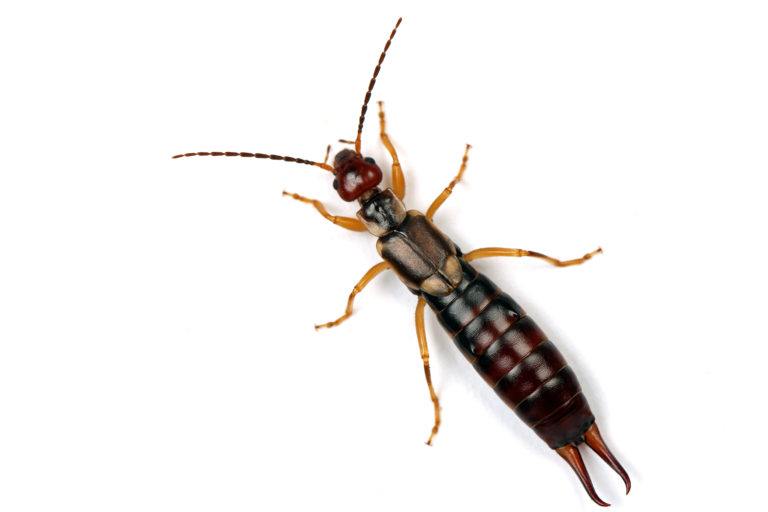
If you really want to get rid of earwigs, the key is disrupting their migration from outdoors to indoors. This works because earwigs rarely establish colonies indoors. Earwigs, Forficula auricularia and Euborellia annulipes, are brown or black insects with a distinctive tail similar to that of the silverfish but with two “prongs” pointing inward rather than three prongs splayed outward. Knowing their characteristics will help with earwig control.
Earwigs get their name from an urban legend whereby during the night they prey on people’s brains by crawling in their ears. Obviously, this isn’t true, but finding a large earwig infestation can be an unsettling discovery. Thankfully, getting rid of earwigs doesn’t require a lot of effort. This article also focuses on how to prevent an earwig infestation and how to get rid of earwigs if they have become established indoors.
Earwig Bites
Earwig bites, despite what some people claim, are quite harmless and never fatal because earwigs don’t exude any poison. Though the earwig’s jaws (forceps) are quite strong and the pinch can be a bit painful, there is no reason to worry about an earwig bite.
Best Methods of Earwig Control
Earwigs are attracted to moist areas like the foundation around your house.
If you want to get rid of earwigs, it is suggested that you clean and groom the areas immediately around the foundation of your home. Gravel and white stones can be layered around the foundation to help drainage around the sides of the home, thus limiting the attraction of earwigs.
Earwigs can gain entrance to your home through ground level windows.
To get rid of earwigs, you’ll want to make sure that screens on your windows are properly fixed and fitted to the window frame. If you find that earwigs are getting in through cracks between the window and the window frame, the problem is easily solved with weather stripping.
Earwigs will enter your home through loose or drafty doors.
If you’re going to get rid of earwigs, you’ll want to seal the more obvious entrances to your home—the doors. Doors and door frames are the most common access points for pests like earwigs. Be sure to examine each doorway into your home and address cracks and holes with weather stripping, caulk, or putty.
Earwigs can be controlled with boric acid powder.
To get rid of earwigs that have made it into your home despite proper sealing and landscaping techniques, spreading a residual insecticide like boric acid near baseboards, cracks, and hard to reach places is recommended. Boric acid is a natural insecticide and works only if the earwig is forced to travel through the powder. You can get Boric Acid powder from Amazon.
Large populations of earwigs can be controlled with a vacuum.
If you find a large colony of earwigs in a concentrated area, the most effective way to get rid of them is to vacuum them up. Be sure to have the vacuum ready before disturbing their resting place because as soon as you get in there, they will scatter. Make sure to empty the vacuum or the vacuum bag in a sealed container and dispose of it immediately. Also, vacuum up any white, egg-like objects around the area.
Killing Earwigs
There are a lot of insecticides and pesticides on the market that will kill earwigs. Sprays are generally not as effective as granule and residual earwig treatments. For basic earwig control and even treatment of large earwig infestations, both an indoor and outdoor earwig control regiment should be instituted. Boric acid powder, insecticide dusts, and other earwig powders and dusts containing pyrethrins are effective earwig control agents in the home. Outside of the home, earwig control agents should be spread 6–10 feet from the foundation outwards, all the way around your home. This type of earwig control is made more effective if sprayed lightly with water to help the poison seep into the ground (2–3 inches) where earwigs generally lay their eggs.
Best Natural Earwig Control Methods
Sodium lights are a somewhat unknown natural pest control tactic.
A lot of insects are more attracted to lights that emit a “bluer” wavelength. Sodium lights emit less blue wave light. Earwigs, being attracted to lights, are less attracted to a sodium light, which means fewer earwigs will find their way into a home that uses sodium lights for outdoor lighting purposes. You can find a wide variety of sodium lighting products at Amazon.
Boric acid, as we’ve noted already, is a natural insecticide that is fairly harmless to human beings and pets.
Other names for this colorless powder are orthoboric acid, boracic acid, or Sassolite (its mineral form). Dusting hard-to-reach places in your home is the most common method of use when implementing boric acid earwig control.